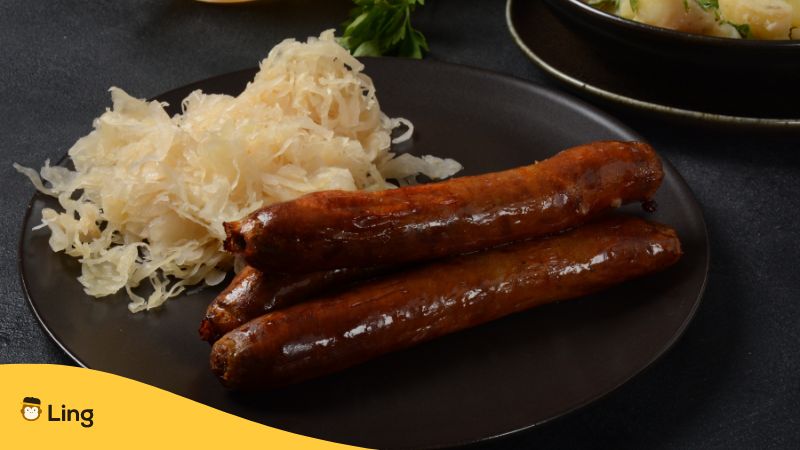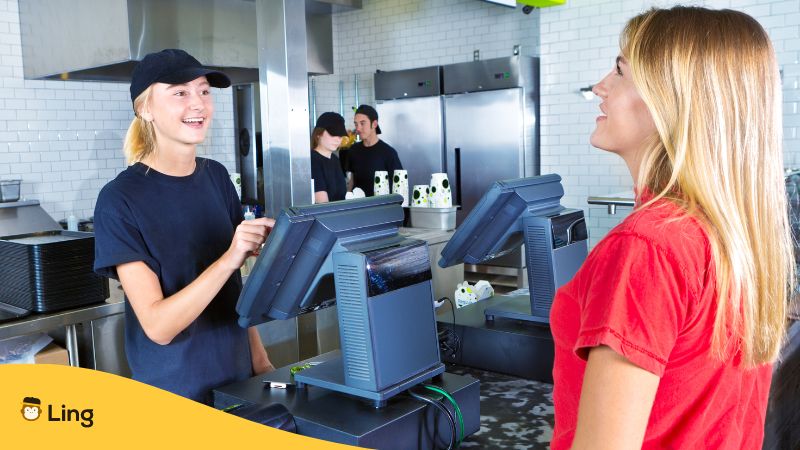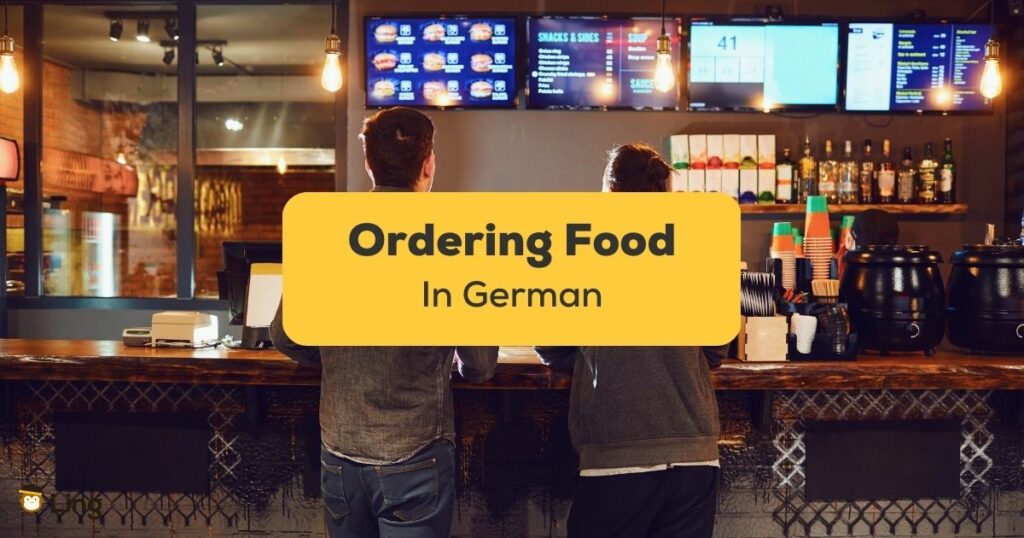Want to order food in German like a native speaker? We honestly can’t blame you! While you can simply order using English or point to the dishes you want to try, nothing beats the excitement of ordering food or Essen in the local language and feeling like the best tourist ever. In this post, we’ll equip you with every phrase and word you need to know to nail your next food order. Let’s begin!
As travelers, we all have our own unique reasons for exploring different parts of the world. Some of us seek to immerse ourselves in the vibrant cultures of Asia, taking in stunning temples and exotic traditions. Others yearn for the enchanting charm of European architecture, with its dreamy cobblestone streets and fairytale-like landmarks. If you’re the latter, visiting German-speaking countries is an absolute must-add to your bucket list! From the Rothenburg in Germany and Hallstatt in Austria to the Andermatt in Switzerland, it’s impossible not to be tempted to twirl in delight ala Disney princess.
However, there’s more to these countries than you can imagine! For instance, taking on a gastronomic adventure in Germany actually quite surprised me. Whenever I think of this country, what usually comes to mind are the Michelin-star quality eats like sausages and potato-based dishes . But boy, I was wrong! During my trip, I got to try out those delectable Kaiserschmarrn and savory Leberknödelsuppe, which totally made me adore German food even more!
But before you run to the nearest German restaurant, we highly recommend that you learn at least the basic words and phrases first! By having a strong foundation on this topic, you can navigate the menu on your own and even make special requests. Ready to learn? Let’s dive right into it!

What Is Food In German?
The word for “food” in German is “Essen.” This is a noun that can refer to any type of food or meal and can be used in various contexts, such as ordering food, cooking, or discussing food preferences. It is mainly used as a subject or object of the sentence and is modified by articles or adjectives.
For example:
- The food tastes very good = Das Essen schmeckt sehr gut.
- We like to eat Italian food = Wir essen gerne italienisches Essen.
- The waiter brings the food to the table = Der Kellner bringt das Essen zum Tisch.
On the other hand, the locals also use the word “esse.” This version is the first-person singular conjugation of the verb “essen.” It is used when the subject of the sentence is “I,” and the verb needs to be conjugated accordingly.
For example:
- I like to eat pizza = Ich esse gerne Pizza.
- I eat my food slowly = Ich esse mein Essen langsam
- I’m eating dinner right now = Ich esse gerade zu Abend.
Now that you know the basic terminology related to this topic, let’s now move forward to the German phrases you need to use to order food like a pro.
How To Order Food In German
Just like in many other countries, locals in Germany typically enjoy three main meals throughout the day: das Frühstück (breakfast), das Mittagessen (lunch), and das Abendessen (dinner). If you’re eager to order your favorite dishes during these times, we’ve got you covered! Below, we’ve compiled the best German phrases and organized them into an easy-to-follow step-by-step guide.

Step 1: Greet And Inquire
As soon as you step foot into a German restaurant, a friendly server will usually greet you and assist you in finding your reserved table. However, it’s worth noting that there are also some establishments where you can simply pop in and seat yourself. Once a server approaches you, feel free to use the following expressions to start your dining experience on the right foot.
| English | German |
|---|---|
| Good day! | Guten Tag! |
| Do you have a reservation? | Haben Sie eine Reservierung? |
| A table for [number] people, please. | Ein Tisch für [Anzahl] Personen, bitte. |
| Can we sit outside/inside? | Können wir draußen/drinnen sitzen? |
| Do you have an English menu? | Haben Sie eine englische Speisekarte? |
| What do you recommend? | Was empfehlen Sie? |
| I’m allergic to [ingredient]. | Ich bin allergisch gegen [Zutat]. |
| Can we see the wine list? | Können wir die Weinkarte sehen? |
| Is there a daily special? | Gibt es ein Tagesgericht? |
| Could we have some water, please? | Könnten wir bitte Wasser haben? |

Step 2: Read The Menu
Now that you’re seated, we bet that the inner child in you will be screaming, “Ich bin hungrig” or “I’m hungry.” To prevent this from happening, ordering your main course and your favorite drink should be done right away. Usually, the servers will automatically give you the menu, but in case they miss it, you can politely ask for it by saying either “Darf ich bitte die Karte sehen?” or “Könnten Sie mir bitte die Speisekarte bringen?“
Once you have the “die Speisekarte” or menu in hand, you should be able to see all the basic categories like the following:
| English | German |
|---|---|
| Appetizers | die Vorspeisen |
| Soups | die Suppen |
| Salads | die Salate |
| Main dishes | die Hauptgerichte |
| Vegetarian dishes | die vegetarischen Gerichte |
| Fruits | das Obst |
| Seafood | die Meeresfrüchte |
| Meat | das Fleisch |
| Poultry | das Geflügel |
| Pasta | die Nudeln |
| Pizza | die Pizza |
| Side dishes | die Beilagen |
| Desserts | die Desserts |
| Beverages | die Getränke |
| Vegetables | das Gemüse |
| Wine | der Wein |
Now that you know the basic parts of the menu, let’s quickly go over some of the German words you’ll come across per category.
Meat
Germany is known for its hearty meat dishes that are often accompanied by potatoes, bread, and vegetables. Some of the top meat dishes in Germany include schnitzel, which is a thin, breaded, and pan-fried meat cutlet that can be made with veal, pork, or chicken and is often served with a side of potato salad or French fries. Want to try these? Order them by remembering the translations below.
| English | German |
|---|---|
| Bacon | der Speck |
| Beef | das Rindfleisch |
| Chicken | das Hähnchen |
| Duck | die Ente |
| Fish | der Fisch |
| Ham | der Schinken |
| Lamb | das Lamm |
| Pork | das Schweinefleisch |
| Rabbit | das Kaninchen |
| Sausage | die Wurst |
| Turkey | die Pute |
| Veal | das Kalbfleisch |
| Venison | das Wildfleisch |
Fruit
While Germany may not be known for its fruit-based dishes, there are still many tasty ways to enjoy fruits in German cuisine. One popular dish is Apfelstrudel, which is a sweet pastry filled with spiced apples and served with vanilla sauce or whipped cream. Another popular dessert is Rote Grütze, which is a berry pudding made with red fruits such as strawberries, raspberries, and currants and is often served with vanilla sauce or cream. To order those correctly, take note of the following translations.
| English | German |
|---|---|
| Apple | der Apfel |
| Banana | die Banane |
| Cherry | die Kirsche |
| Grapes | die Trauben |
| Kiwi | die Kiwi |
| Lemon | die Zitrone |
| Mango | die Mango |
| Orange | die Orange |
| Peach | der Pfirsich |
| Pear | die Birne |
| Pineapple | die Ananas |
| Plum | die Pflaume |
| Strawberries | die Erdbeeren |
| Watermelon | die Wassermelone |
Vegetables
Germany is a country that appreciates fresh and flavorful vegetables, and many traditional German dishes are built around these healthy ingredients. One popular vegetable dish is sauerkraut, which is a fermented cabbage that is often served as a side dish or as a topping on sausages or pork dishes. To see whether what you’re ordering contains veggies, take note of the translations below.
| English | German |
|---|---|
| Beans | die Bohnen |
| Bell pepper | der Paprika |
| Broccoli | der Brokkoli |
| Cabbage | der Kohl / das Kraut |
| Carrot | die Karotte / die Möhre |
| Cauliflower | der Blumenkohl |
| Cucumber | die Gurke |
| Garlic | der Knoblauch |
| Lettuce | der Salat |
| Mushroom | der Pilz |
| Onion | die Zwiebel |
| Peas | die Erbsen |
| Potato | die Kartoffel |
| Spinach | der Spinat |
| Tomato | die Tomate |
Drinks
Germany has a rich and diverse drinking culture that encompasses a wide range of beverages, both alcoholic and non-alcoholic. One of the most popular beverages in Germany is beer, with Germany being home to over 1,500 breweries and a wide variety of beer styles. So if you want to order one, remember the translation for it, which you can find below.
| English | German |
|---|---|
| Alcoholic cocktail | der Cocktail |
| Beer | das Bier |
| Coca-Cola | die Cola |
| Coffee | der Kaffee |
| Energy drink | der Energy-Getränk |
| Hot chocolate | der heiße Kakao |
| Iced tea | der Eistee |
| Juice | der Saft |
| Lemonade | die Limonade |
| Milk | die Milch |
| Smoothie | der Smoothie |
| Sparkling water | das Sprudelwasser |
| Tea | der Tee |
| Water | das Wasser |
| Wine | der Wein |

Step 3: Order Food And Drinks
Feel like you’re finally ready to delight your tastebuds? If you are, don’t be afraid to call the attention of the servers by saying “Entschuldigung” and starting your sentence with either Ich möchte(I would like) + the name of the dish or Ich hätte gern(I would like) + the name of the dish. The first phrase is more direct and common, while the second phrase is more polite and formal.
For example:
- I would like two bread rolls, please = Ich hätte gern zwei Brötchen bitte.
- I would like a Schnitzel, please = Ich hätte gern das Schnitzel, bitte.
- I would like apple juice = Ich möchte einen Apfelsaft.

Step 4: Make Special Requests
When dining in a German restaurant, it’s important to be able to communicate your specific food preferences and needs. Whether you have dietary restrictions or simply want to make a special request, knowing how to ask for what you want in German can help ensure that you have an enjoyable and satisfying dining experience. In this table, we’ve compiled a list of useful phrases for making special requests when ordering in German.
| English | German |
|---|---|
| Can I have …? | Kann ich bitte … haben? |
| I’m allergic to … | Ich bin allergisch gegen … |
| Could you make it without …? | Könnten Sie es bitte ohne … machen? |
| I would like extra … | Ich hätte gerne extra … |
| Could you please add…? | Könnten Sie bitte … hinzufügen? |
| Is it possible to …? | Ist es möglich, … zu machen? |
| Could I substitute … for …? | Könnte ich … gegen … austauschen? |
| Could you make it spicy/mild? | Könnten Sie es scharf/mild machen? |
| Could you please bring me …? | Könnten Sie mir bitte … bringen? |
| I don’t eat … | Ich esse kein/e … |

Step 5: Ask For The Check
While tipping is not mandatory, leaving a small amount of money as a gesture of appreciation for good service is common. When I picked the brain of the locals, the consensus was that a tip of 5-10% of the total bill is considered appropriate. However, some restaurants may automatically include a service charge in the bill, so it’s important to check before leaving a tip. And speaking of the bill, here are the top phrases you need to master related to that aspect.
| English | German |
|---|---|
| Could I have the check, please? | Kann ich bitte die Rechnung haben? |
| I’m finished/done. | Ich bin fertig. |
| That was delicious. | Das war köstlich. |
| Could I have a to-go box, please? | Kann ich bitte eine To-Go-Box haben? |
| Can I pay with card/cash? | Kann ich mit Karte/Geld bezahlen? |
| Thank you for the meal. | Vielen Dank für das Essen. |
| May I leave now? | Kann ich jetzt gehen? |
| Do I need to pay at the register? | Muss ich an der Kasse bezahlen? |
| Could you please split the bill? | Könnten Sie bitte die Rechnung aufteilen? |
| Could I have a doggy bag, please? | Kann ich den Rest einpacken bitte? |
Ready To Learn More Phrases In German?
Looking to learn a new language and spice up your life? Look no further than Ling! This leading language-learning platform is taking the world by storm with its cutting-edge features and personalized approach to teaching a foreign language. With it, you can learn German and 60+ other languages through fun and engaging lessons, interactive exercises, and real-time feedback. Plus, with its speech recognition and chatbot technology, you’ll be speaking like a native in no time!
So what are you waiting for? Try out Ling today by downloading it from Play Store or App Store.



































































